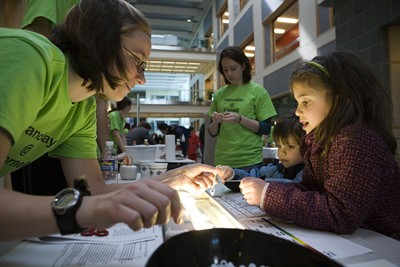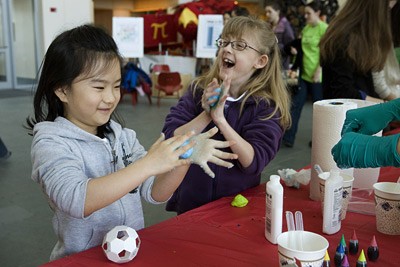Area students learn how small particles make a big difference at Cornell's NanoDay
By Nina Zhang
How small is a nanometer? What is nanotechnology? Hundreds of local children as well as numerous adults found out March 30 while also making slime and silly putty, extracting salmon DNA and making their own liquid crystal cards at Cornell's first annual NanoDay, an open house in Duffield Hall about nanotechnology and its uses, hosted by Cornell's Nanobiotechnology Center.
"We wanted people to know that nanotechnology is part of their lives, from when they put on sunscreen to when they use their cell phones," said Martin Alderman, Physics Teacher Education Coalition Teacher in Residence and a volunteer at the workshop on atomic force microscopy, where students learned about the frustrations of detecting molecules on their own by mapping the design of an unknown Lego structure with a probe that follows the shape of the surface.
"We teach kids that it is essential to have a nano-sized probe to study nanostructures," said workshop coordinator Julie Nucci, who is director of Education Programs of Cornell's Center for Nanoscale Systems. Nucci holds the same workshop for high school physics teachers so they can teach their students the same ideas.
The event is aimed to reduce the public's fear of nanotechnology, said Nucci, because people tend to fear what they do not understand.
Although "nano" has become a buzzword, nanotechnology is manipulating matter on a nanoscale so that the properties of that matter changes. A single strand of hair is approximately 100,000 nanometers wide, participants at NanoDay learned, so manipulating particles of that size has led to some sophisticated applications. Nanotechnology has enabled us to analyze DNA on a single molecule, for example, with the added benefit of having to use fewer blood samples, said applied physics graduate student Leon Bellan. In the family-oriented lecture, "What Is Nano About the iPod Nano?" Sandip Tiwari, the Charles N. Mellowes Professor in Engineering and director of the National Nanotechnology Infrastructure Network, said that the beauty and simplicity of the iPod arises from the complexity, miniaturization and use of nanoscale phenomena.
In demonstrations and hands-on activities, run by student volunteers in the Duffield atrium, participants saw, for example, the magnetic property of ferrofluid, developed from nanotechnology, even though magnetism is often a property of solids. Participants also smashed denture cleansers and compared their reaction time in water to whole denture cleansers, demonstrating the faster reaction time of smaller particles.
Alex Cain '10, brought Dekhari Stewart and Janell Coleman, fifth-graders at Belle Sherman Elementary School, as part of the Big Brother/Big Sister program. "It was fun," said Stewart of the denture cleansers demonstration. "We don't learn about this in school."
The event is part of Nanoweek, a week of community-based educational outreach events across the country, coordinated by Nanoscale Informal Science Education Network, a network of science museums.
Nina Zhang '09 is a writer intern at the Cornell Chronicle.
Media Contact
Get Cornell news delivered right to your inbox.
Subscribe
